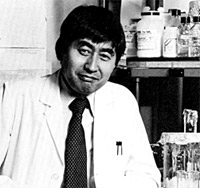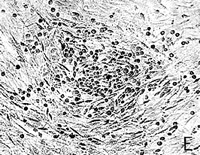Twists and Unexpected Turns in the Genetics of Cancer-Causing Viruses

Hanafusa, Hidesaburo
In 1911 Rockefeller scientist Peyton Rous isolated a cancer-causing virus from a tumor in chickens. The virus became known as the Rous sarcoma virus (RSV), and thereafter researchers struggled for decades to understand just how it transforms normal cells into cancerous ones. Then, in the early 1970s, a series of discoveries made it possible to unravel the genetics of this problem. Rockefeller's Hidesaburo Hanafusa (1929-2009) solved a key piece of the puzzle in 1977. He found that crippled forms of RSV, which contained only part of the sequence of the crucial cancer-causing src gene, still could give rise to tumors. Then he isolated virus containing the full gene sequence from these tumors: the virus had recombined with a similar gene found in normal cells to fill in the missing pieces of the gene. Hanafusa had uncovered a mechanism by which retroviruses like RSV can bring about tumors by picking up oncogenes from normal cells.
Hanafusa had begun studying RSV in the early 1960s as a postdoctoral fellow in the laboratory of Harry Rubin at the University of California at Berkeley. (Rubin had pioneered in developing an assay that made it possible to study the infection of individual cells with RSV.) There Hanafusa discovered an RSV mutant that could transform cells but could not replicate itself. It was the first time such a defect had been found in an animal virus (defective bacteriophage-viruses that infect bacteria-were known). More mutants were soon identified by Hanafusa and others, and researchers used these as tools to pick apart the viral genome and identify src, the gene responsible for cellular transformation. Hanafusa also found an RSV mutant whose ability to induce transformation was temperature-sensitive; this mutant was widely used by other researchers.
The techniques available in the 1960s for both finding genes and teasing apart the details of virus replication were, however, very cumbersome. Howard Temin had suggested that RSV and other retroviruses could make DNA copies of their RNA genomes, then insert these into the DNA of infected cells. Thus a retrovirus could hijack a cell's molecular biologic machinery to reproduce itself. When David Baltimore found the enzyme reverse transcriptase, which makes DNA copies from RNA, scientists had both a mechanism to explain retrovirus replication and a tool for probing the process. Then Harold Varmus and J. Michael Bishop made the startling discovery, in normal cells, of a gene that was nearly identical to viral src, and they found the gene in many species, including humans. Hanafusa's work in the 1970s helped provide a detailed account of how this oncogene, in concert with viral infection, gives rise to cancer. In 1988 Hanafusa discovered a new oncogene in an avian sarcoma virus, crk. His later research also focused on src regulation, and the structure and function of Src-family proteins.

Foci of transformed cells induced by SR-RSV-A. From J Exp Med, 1977, 146: 1735-1747
For their discoveries concerning tumor viruses and oncogenes, Varmus, Bishop, and Hanafusa shared the 1982 Albert Lasker Basic Medical Research Award, along with two others: Raymond Erikson, who first identified the protein products of oncogenes, and Robert Gallo, whose research led to the discovery of the first human RNA tumor virus and its association with certain leukemias and lymphomas. Bishop and Varmus received the Nobel Prize in 1989 for their discovery of the cellular origin of retroviral oncogenes. Baltimore and Temin shared the 1975 Nobel Prize, along with Renato Dubecco, for their discoveries concerning the interaction between tumor viruses and the genetic material of the cell.
Hidesaburo Hanafusa received his undergraduate degree (1958) and PhD (1960) from Osaka University. From 1961 to 1964 he was a visiting scientist at the University of California, Berkeley. He then spent two years as a visiting scientist at the College de France. In 1966 he returned to the U.S. to become director of the Public Health Research Institute of the City of New York. In 1973 he joined the Rockefeller University faculty, and in 1986 was named Leon Hess Professor. Hanafusa's achievements were recognized with the Howard Taylor Ricketts Award (1981), the Lasker Award (1982), the Asahi Press Prize (1984), the Clowes Memorial Award of the American Association of Cancer Research (1986), the Sloan Prize (1993), and the Japan Order of Culture (1995). He was a foreign associate of the U.S. National Academy of Sciences (1985). In 2000, The Rockefeller University awarded Hanafusa an honorary doctorate, and he became a member of the Japan Academy.
Selected Publications
Temin HM and Rubin H. Characteristics of an assay for Rous sarcoma virus and Rous sarcoma cells in tissue culture. Virology, 1958, 6:669-688
Hanafusa H, Hanafusa T, and Rubin H. The defectiveness of Rous sarcoma virus. Proc Natl Acad Sci USA, 1963, 49:572-580
Hanafusa H. Analysis of the defectiveness of Rous sarcoma virus. 3. Determining influence of a new helper virus on the host range and susceptibility to interference of RSV. Virology, 1965, 25:248-255
Kawai S, Hanafusa H. The effects of reciprocal changes in temperature on the transformed state of cells infected with a rous sarcoma virus mutant. Virology, 1971, 46:470-479
Hanafusa H, Halpern CC, Buchhagen DL, and Kawai S. Recovery of avian sarcoma virus from tumors induced by transformation defective mutants. J Exp Med, 1977, 146:1735-1747
http://jem.rupress.org/cgi/reprint/146/6/1735
Takeya T and Hanafusa H. Structure and sequence of the cellular gene homologous to the RSV src gene and the mechanism for generating the transforming virus. Cell, 1983, 32:881-890
Mayer BJ and Hanafusa H. Mutagenic analysis of the v-crk oncogene: requirement for SH2 and SH3 domains and correlation between increased cellular phosphotyrosine and transformation. J Virol, 1990, 64:3581-3589
Waksman G, Kominos D, Robertson SC, Pant N, Baltimore D, Birge RB, Cowburn D, Hanafusa H, Mayer BJ, Overduin M, et al. Crystal structure of the phosphotyrosine recognition domain SH2 of v-src complexed with tyrosine-phosphorylated peptides. Nature, 1992, 358:646-653
Further Reading
Martin GS. The road to Src. Oncogene 23, 2004, 7910-7917
http://www.nature.com/onc/journal/v23/n48/full/1208077a.html
Van Epps HL. Peyton Rous: father of the tumor virus. J Exp Med, 2005, 201:320
http://jem.rupress.org/cgi/content/full/201/3/320
An interview with Dr. Hidesaburo Hanafusa in honor of his cultural medal. Uirusu, 1996, 46:185-190 (in Japanese)
Links
Albert Lasker Basic Medical Research Award, 1982
http://www.laskerfoundation.org/awards/1982basic.htm
